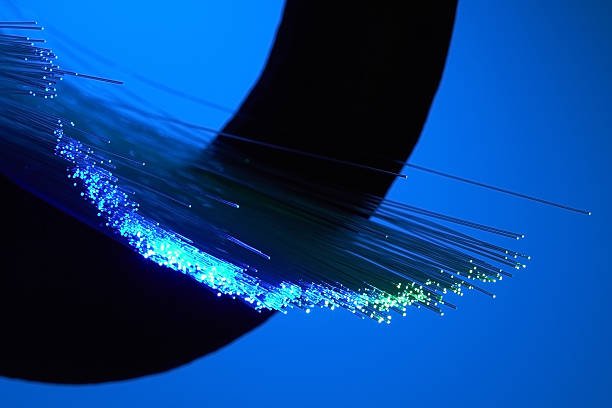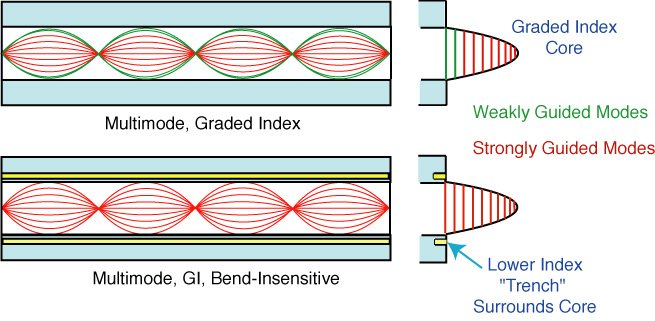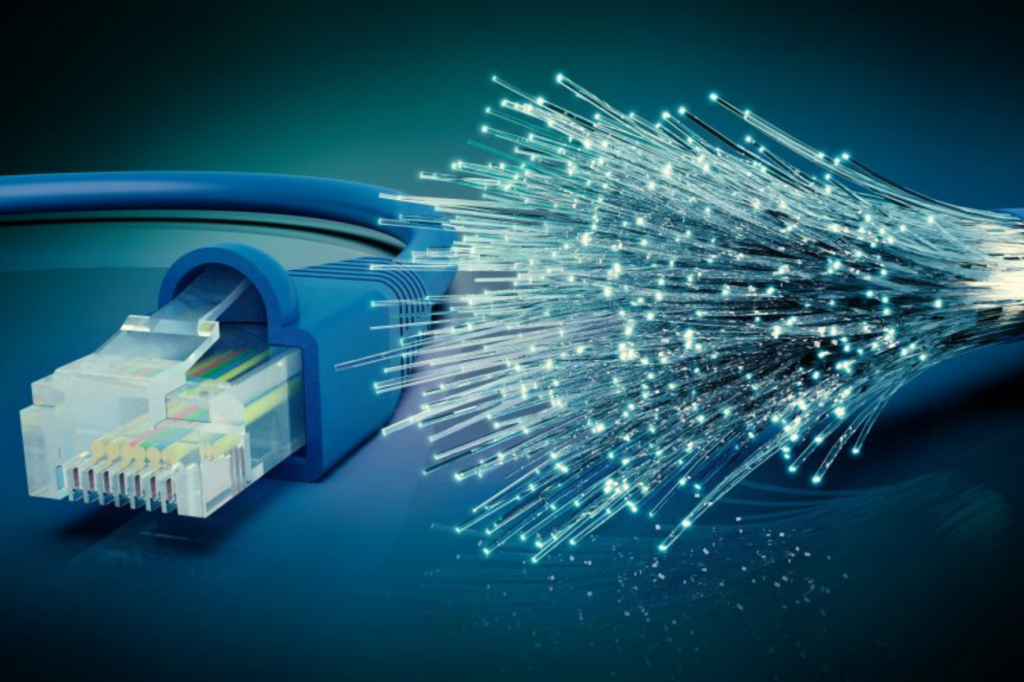Contents
Introduction to Bend-Insensitive Fiber optic cable
Bend-insensitive fiber represents a significant advancement in fiber optic technology, offering enhanced flexibility without compromising data transmission capabilities. Understanding how it works and its applications is crucial for industries reliant on high-speed data transfer.

What Is Bend Insensitive Fiber Optic Cable
Bend insensitive fiber optic cable is a type of optical fiber cable designed to withstand tight bends without significant signal loss or damage to the cable. Traditional optical fiber cables are sensitive to bending, which can lead to signal attenuation or even breakage of the fibers, resulting in compromised performance or complete failure of the cable.
Bend insensitive fiber optic cables are engineered with special designs and materials to mitigate these issues. They typically feature a more flexible outer jacket and a core that is more resistant to bending-induced signal loss. This allows the cable to be routed through tight spaces or around corners without negatively affecting signal quality.
Bend insensitive fiber optic cables are particularly useful in applications where tight bends are unavoidable, such as in data centers, residential installations, or industrial environments. They help ensure reliable and efficient transmission of data over optical fiber networks, even in challenging installation conditions.
How to Calculate the Bending Radius of an Optical Cable?
The bending radius (R) can be calculated using the formula: R = k * D
Where:
-
- R is the bending radius
-
- k is a factor (usually specified by the manufacturer or industry standards)
-
- D is the cable diameter
The value of k depends on the specific cable construction and material properties. It is typically a fraction or multiplier (e.g., 8x, 10x, etc.) of the cable diameter.

Bend Insensitive Fiber Optic Cable Types
Single-mode bend insensitive fiber optic cable:
Single-mode fiber optic cables are designed to carry a single mode of light propagation, allowing for high-speed and long-distance transmission of data. Bend insensitive single-mode cables are specifically engineered to maintain signal integrity even when subjected to tight bends. This is crucial for applications requiring reliable data transmission over extended distances.
These cables are commonly used in telecommunications networks, long-haul installations, and other applications where minimal signal loss and high bandwidth are essential. By minimizing signal attenuation caused by bends, single-mode bend insensitive fiber optic cables ensure efficient transmission of data over optical fiber networks, contributing to improved performance and reliability.

Multimode bend insensitive fiber optic cable:
Multimode fiber optic cables are designed to carry multiple modes of light propagation, allowing for the transmission of data over shorter distances at high speeds. Bend insensitive multimode cables are engineered to withstand tight bends without significant signal loss, making them suitable for use in environments where space constraints or tight bends are common.
These cables are often utilized in data centers, local area networks (LANs), and other high-speed communication systems where flexibility and ease of installation are important factors. By incorporating bend insensitivity, multimode fiber optic cables enable reliable data transmission over short to medium distances, supporting various applications such as high-speed internet, video streaming, and data storage.
In summary, both single-mode and multimode bend insensitive fiber optic cables offer enhanced flexibility and reliability in data transmission by minimizing signal loss caused by tight bends, albeit serving different purposes in terms of distance and bandwidth requirements.

Advantages of Bend Insensitive Fiber Optic Cable
Bend insensitive fiber optic cables offer several advantages over traditional fiber optic cables:
-
- Improved Flexibility: Bend insensitive cables are designed to tolerate tighter bends without experiencing significant signal loss or damage. This enhanced flexibility allows for easier installation in confined spaces and around corners, reducing the need for specialized routing and minimizing the risk of cable damage during installation or maintenance.
-
- Enhanced Reliability: By minimizing signal attenuation caused by bending, bend insensitive fiber optic cables ensure more reliable data transmission over optical fiber networks. This reliability is particularly important in critical applications such as telecommunications, data centers, and industrial environments, where uninterrupted connectivity is essential.
-
- Increased Durability: Bend insensitive cables are engineered with materials and designs that enhance their resistance to physical stress and environmental factors. This increased durability helps prevent fiber breakage or damage due to bending, vibration, temperature fluctuations, and other external influences, resulting in longer-lasting and more robust fiber optic connections.
-
- Cost Savings: The improved flexibility and durability of bend insensitive fiber optic cables can lead to cost savings over time. These cables may require less frequent replacement or repair, reducing maintenance expenses and downtime associated with cable failures. Additionally, their ease of installation and compatibility with standard fiber optic components can streamline deployment and reduce labor costs.
-
- Versatility: Bend insensitive fiber optic cables are available in various types and configurations to suit a wide range of applications and environments. Whether used indoors or outdoors, for long-distance transmission or short-distance connections, these cables offer versatility and adaptability to meet diverse networking needs.
-
- Future-Proofing: As technology advances and network requirements evolve, bend insensitive fiber optic cables provide a future-proofing advantage. Their ability to accommodate tighter bends and maintain signal integrity ensures compatibility with emerging technologies and allows for scalability without the need for extensive infrastructure upgrades.
Are Bend-Sensitive Fibers Compatible with Normal Fibers?
Yes, bend-insensitive fibers are compatible with normal fibers. Bend-insensitive fibers are engineered to withstand tighter bends without significant signal loss or damage compared to traditional fibers, but they are designed to work seamlessly within standard fiber optic systems.
These fibers are manufactured to have the same core and cladding dimensions as standard fibers, ensuring compatibility with existing fiber optic components such as connectors, splices, and transceivers. This means that bend-insensitive fibers can be easily integrated into optical networks alongside normal fibers without any special adjustments or modifications required.
The compatibility of bend-insensitive fibers with normal fibers makes them a convenient and practical choice for upgrading or expanding existing fiber optic infrastructure, as well as for new installations where improved bend performance is desired. It allows for flexibility in designing and optimizing optical networks while maintaining interoperability with existing equipment and technologies.
Conclusion
In conclusion, bend-insensitive fiber represents a groundbreaking innovation in the field of fiber optics, offering unparalleled flexibility and reliability in data transmission. Its ability to withstand tight bends and harsh environmental conditions makes it indispensable across various industries, from telecommunications to healthcare and beyond.
As we continue to rely on high-speed data transfer for communication, commerce, and innovation, bend-insensitive fiber paves the way for enhanced connectivity and efficiency. Its compatibility with existing optical networks and future-proof design position it as a cornerstone technology for the evolving digital landscape.
Investing in bend-insensitive fiber not only ensures seamless data transmission but also future-proofs infrastructure against the demands of tomorrow. With its proven performance and promising prospects, bend-insensitive fiber is set to shape the future of optical communication, driving advancements in technology and connectivity worldwide.

